-
InfluxDB时序数据库安装和使用
安装
下载
wget https://dl.influxdata.com/influxdb/releases/influxdb2-2.4.0-linux-amd64.tar.gz- 1
安装(没有/opt/module/目录的话先创建)
tar -zxvf influxdb2-2.4.0-linux-amd64.tar.gz -C /opt/module/- 1
运行
cd /opt/module/influxdb2_linux_amd64/ ./influxd- 1
- 2

访问页面
http://192.168.233.128:8086/
看到下面页面表示influxdb启动成功~

初始化 设置用户密码 组织结构 存储桶
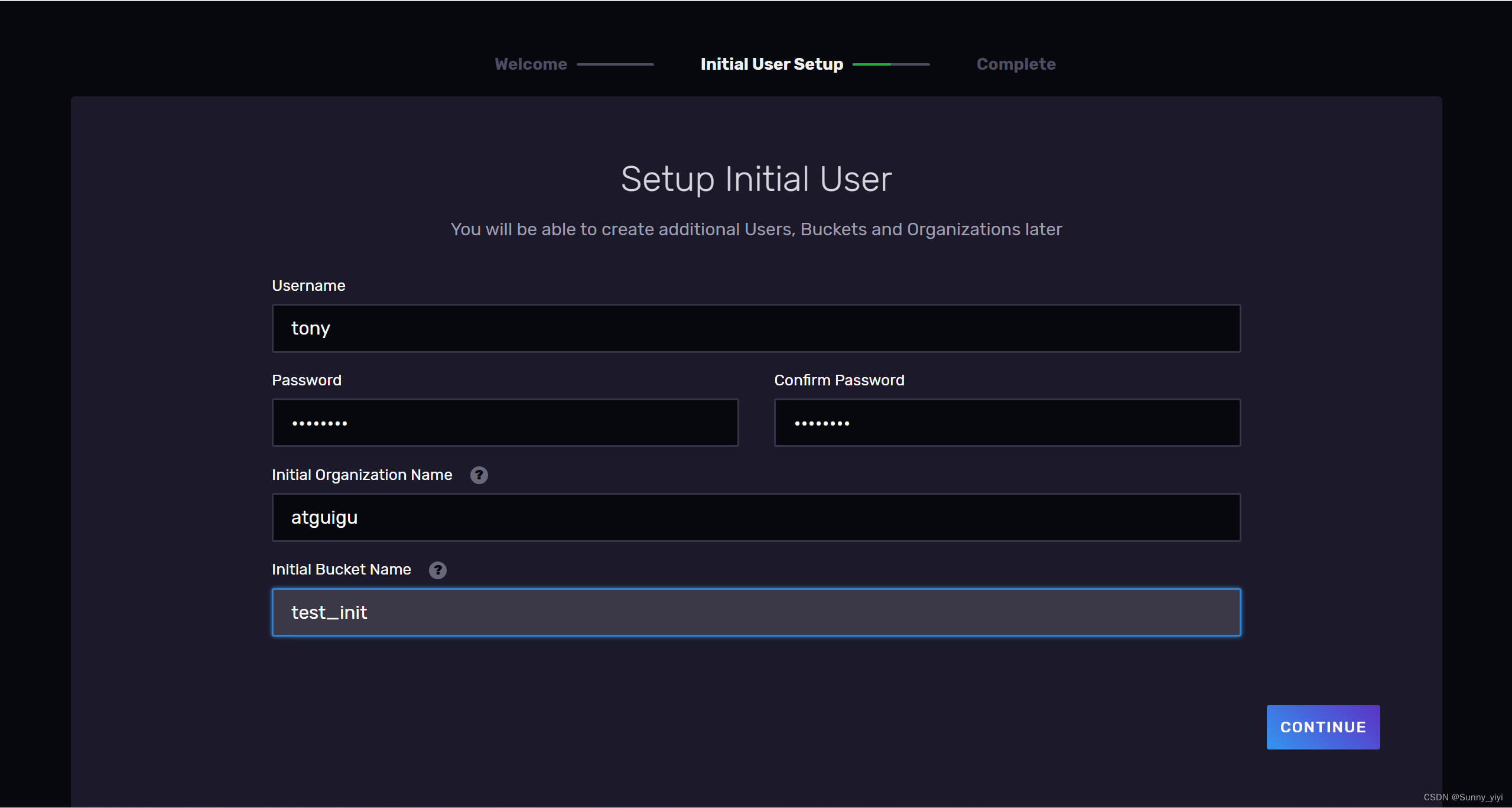


Load Data( 数据来源 )
行协议
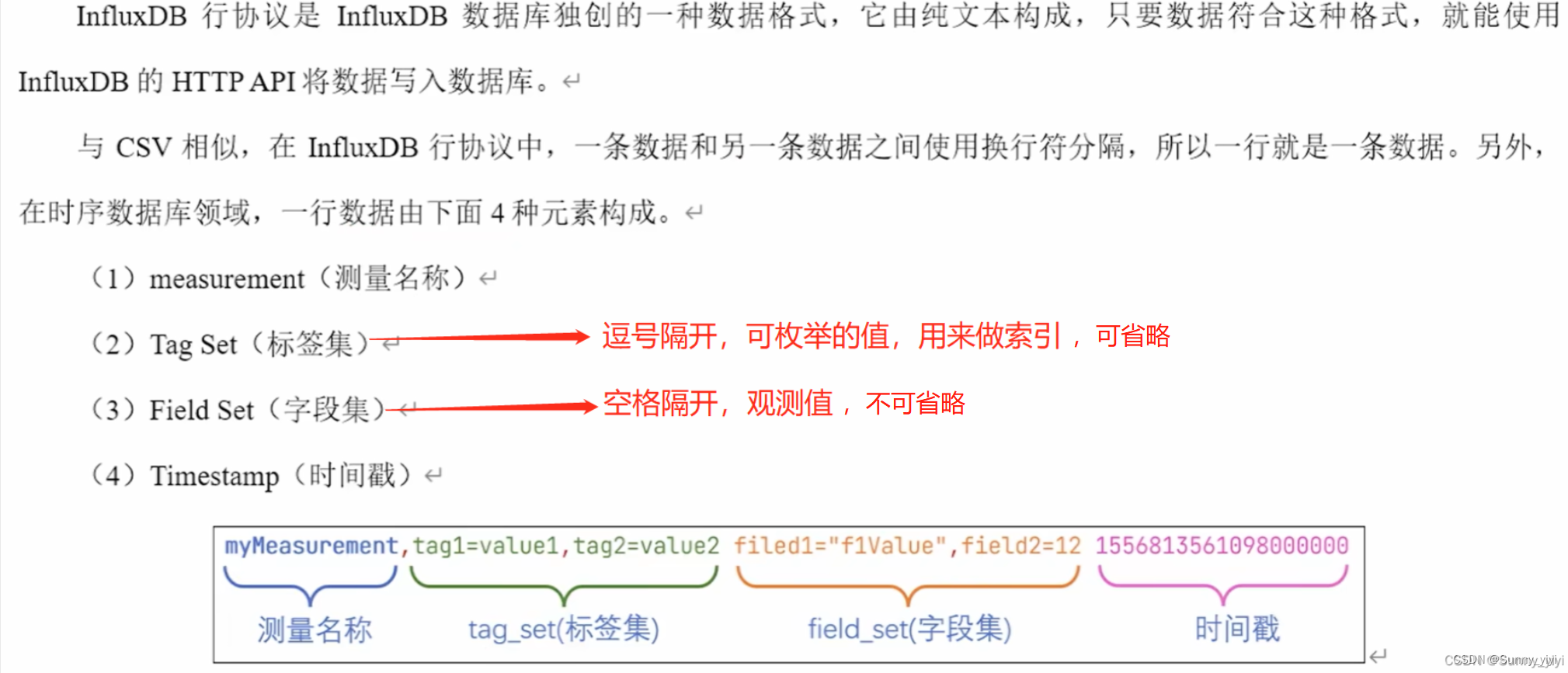
使用telegraf获取数据来源
1、新建存储桶example02

2、创建一个配置
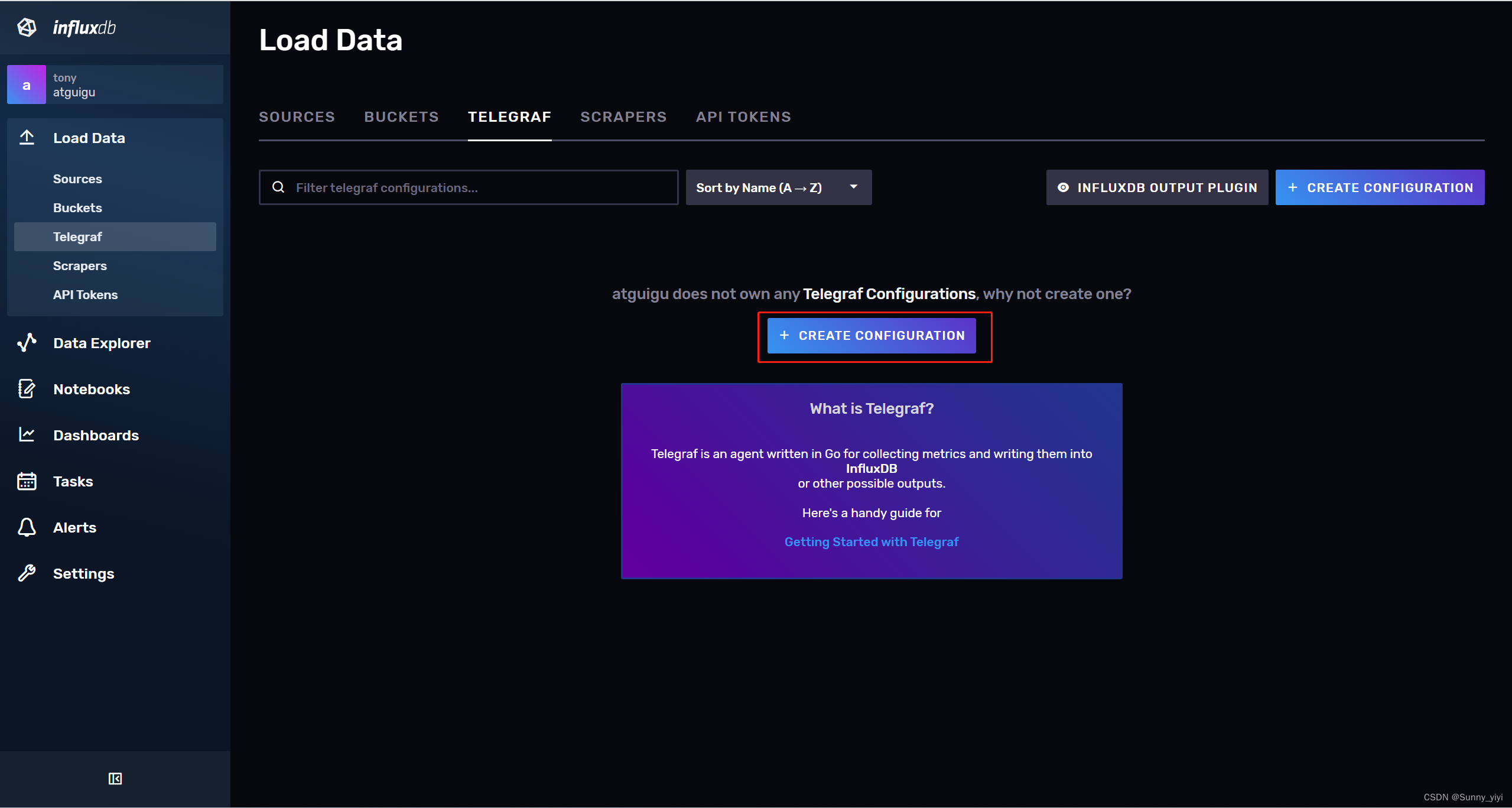



3、下载安装telegrafwget https://dl.influxdata.com/telegraf/releases/telegraf-1.23.4_linux_amd64.tar.gz tar -zxvf telegraf-1.23.4_linux_amd64.tar.gz -C /opt/module/ cd /opt/module/telegraf-1.23.4/usr/bin- 1
- 2
- 3
复制API Token 到/opt/module/telegraf-1.23.4/usr/bin目录下粘贴,按回车
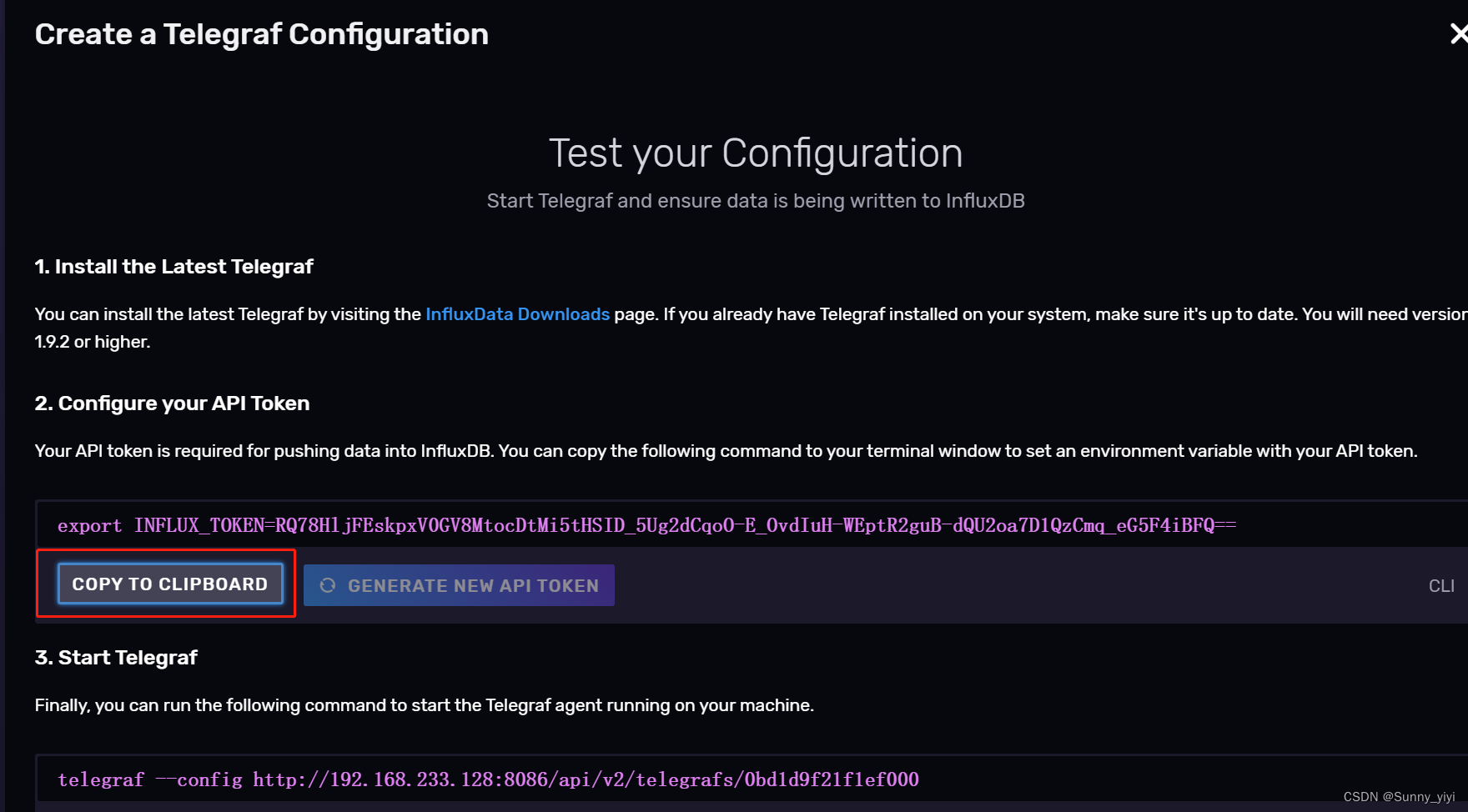

env命令就能看到这个环境变量

启动telegraf

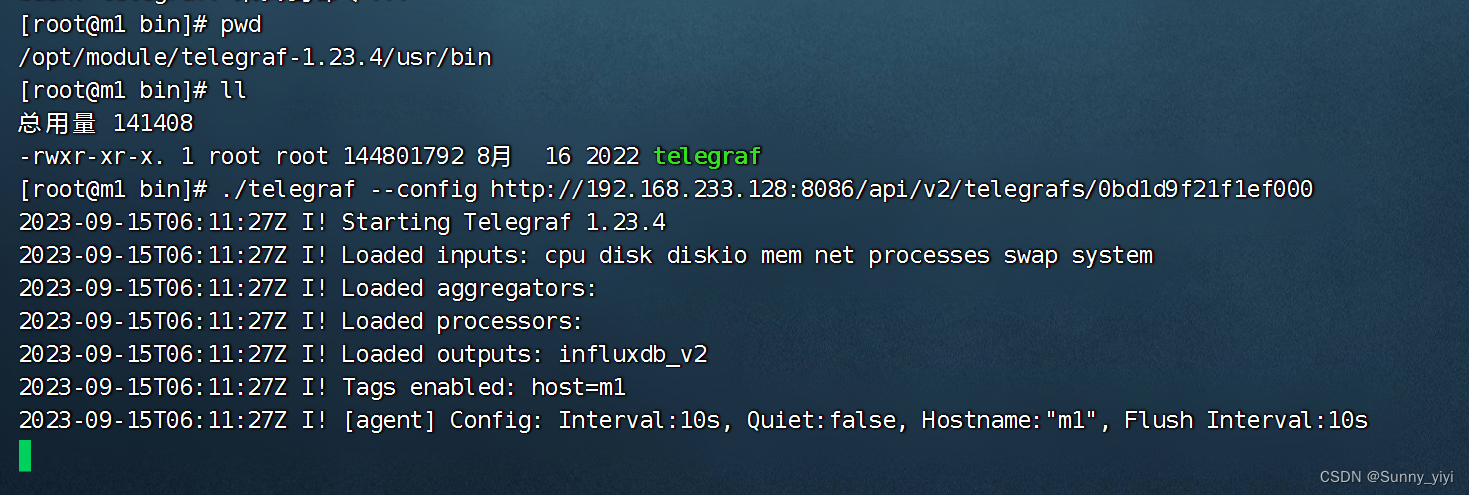
然后在控制Data Explorer面板就能看到从telegraf发送到InfluxDB的数据
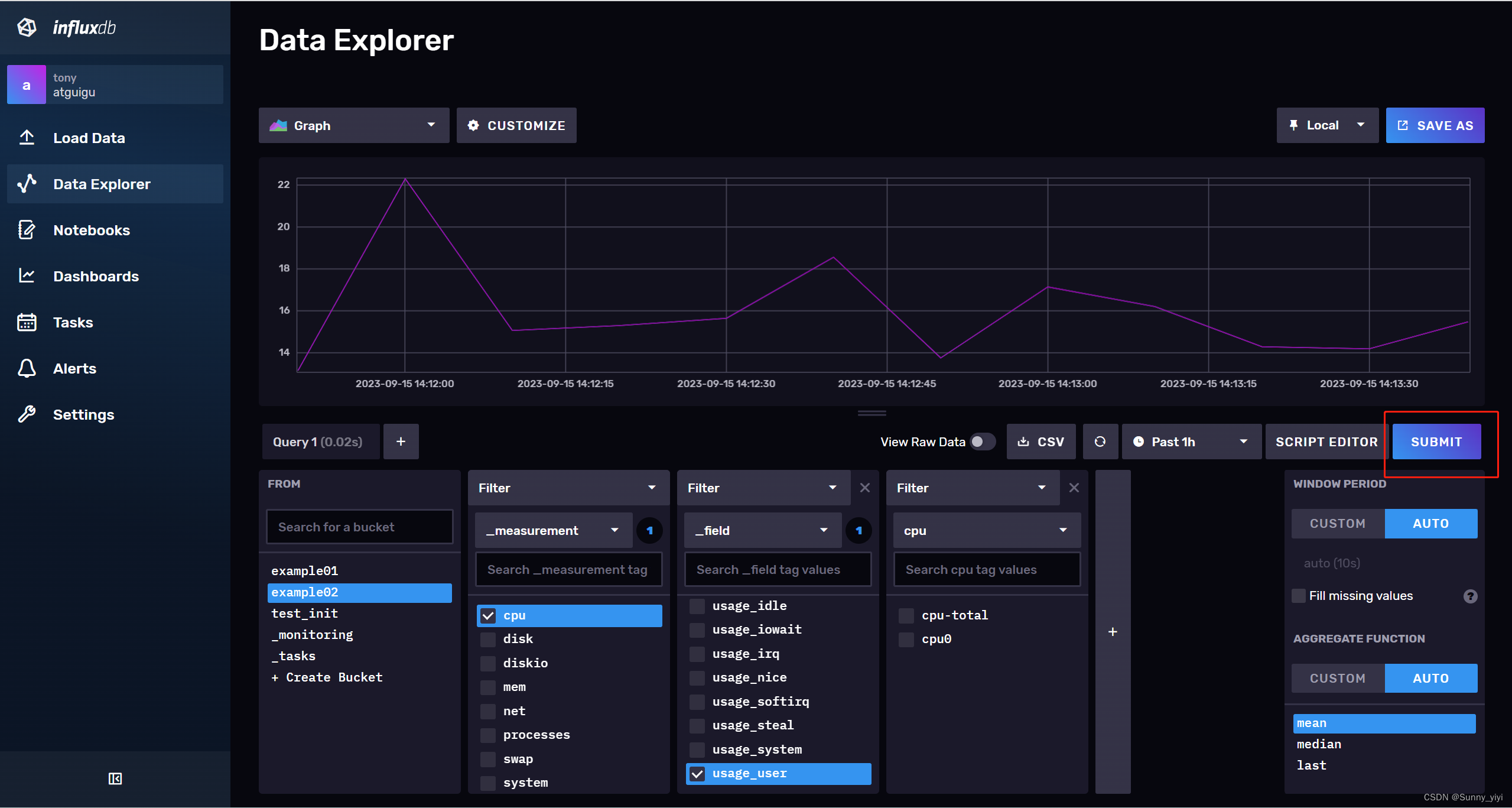
使用Scrapers获取数据来源
1、下载安装启动 普罗米修斯
wget https://github.com/prometheus/node_exporter/releases/download/v1.6.1/node_exporter-1.6.1.linux-amd64.tar.gz tar -zxvf node_exporter-1.6.1.linux-amd64.tar.gz -C /opt/module/ cd /opt/module/node_exporter-1.6.1.linux-amd64 ./node_exporter- 1
- 2
- 3
- 4

访问:http://192.168.233.128:9100/metrics
就能看到监控系统情况数据指标
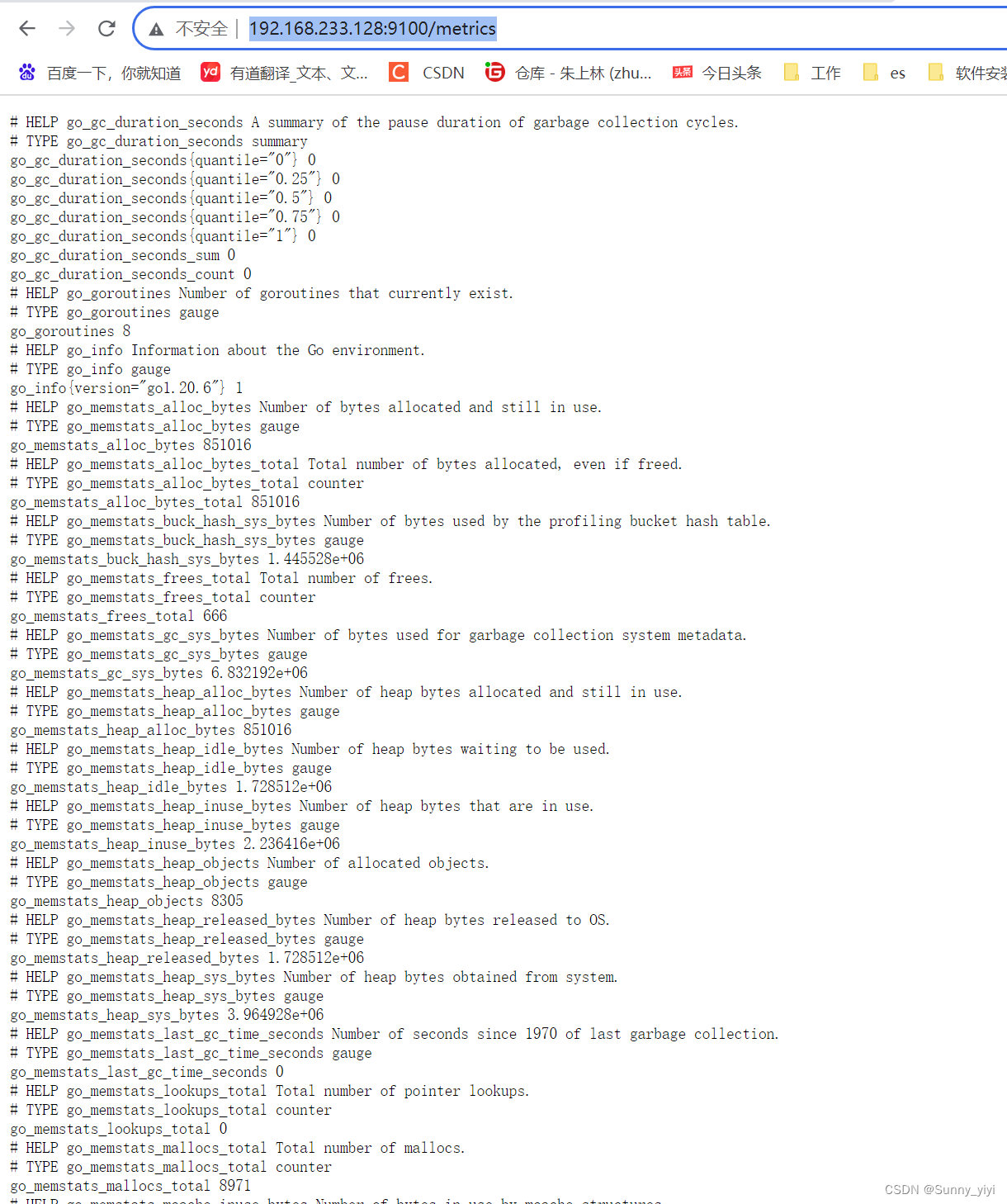
2、创建新的存储桶example03
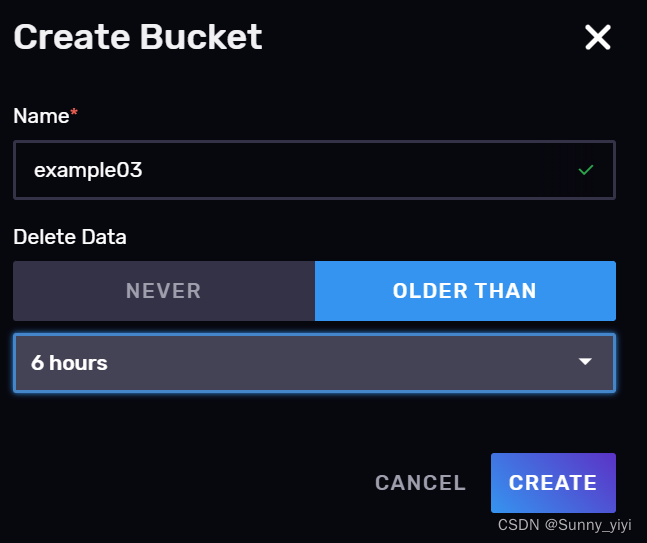
3、创建新的Scraper
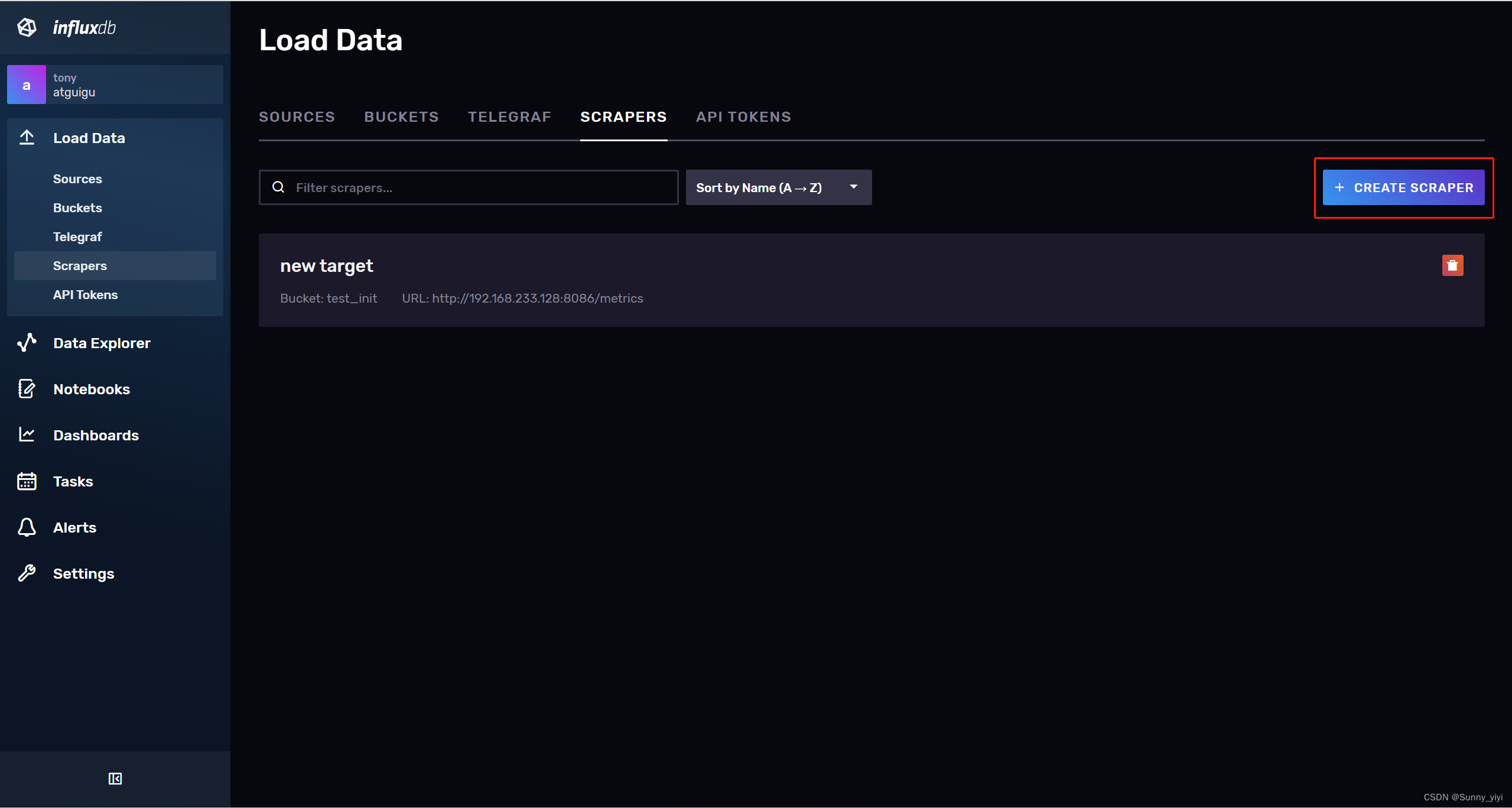
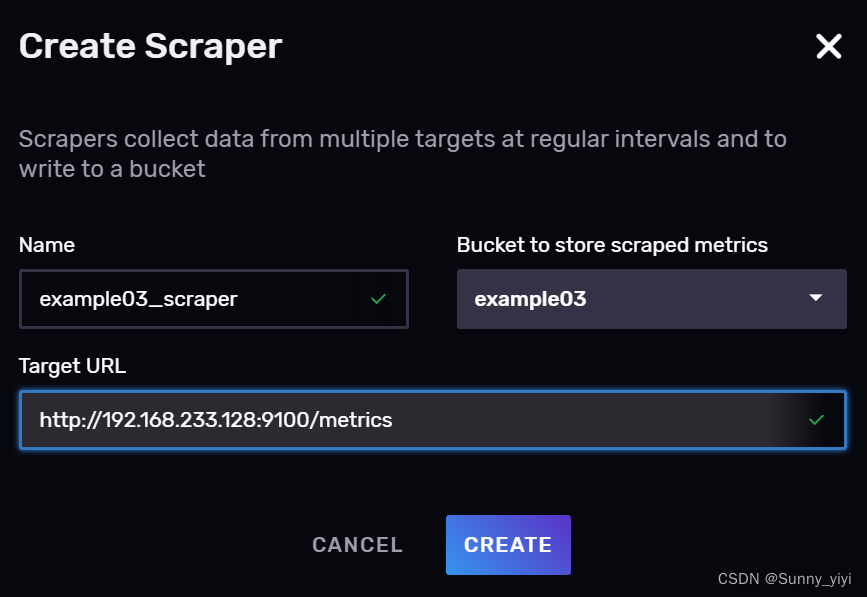
Java操作InfluxDB
controller
package cn.tedu.springboot_quick.controller; import cn.tedu.springboot_quick.InfluxDB.InfluxDbMapper; import cn.tedu.springboot_quick.InfluxDB.MeasurementCpu; import cn.tedu.springboot_quick.common.CommonResult; import cn.tedu.springboot_quick.common.utils.ResultUtil; import cn.tedu.springboot_quick.entity.Menus; import cn.tedu.springboot_quick.service.MenusService; import io.swagger.annotations.Api; import io.swagger.annotations.ApiOperation; import org.influxdb.dto.BatchPoints; import org.influxdb.dto.Point; import org.springframework.beans.factory.annotation.Autowired; import org.springframework.web.bind.annotation.GetMapping; import org.springframework.web.bind.annotation.RequestMapping; import org.springframework.web.bind.annotation.RestController; import java.util.HashMap; import java.util.List; import java.util.Map; import java.util.concurrent.TimeUnit; /** ** 前端控制器 *
* * @author zhushagnlin * @since 2021-07-12 */ @Api(tags = "InfluxDB") @RestController @RequestMapping("/influx") public class InfluxDBController { @Autowired InfluxDbMapper influxDbMapper; @ApiOperation(value = "InfluxDB插入",tags = "InfluxDB") @GetMapping("/insertInfluxDB") public CommonResult insertInfluxDB(){ // 创建点数据 Point point1 = Point.measurement("cpu") .time(System.currentTimeMillis()+ 8 * 60 * 60 * 1000L, TimeUnit.MILLISECONDS) .tag("tag1","tag111") .tag("tag2","tag222") .addField("value", 80) .addField("host", "server1") .build(); Point point2 = Point.measurement("cpu") .time(System.currentTimeMillis()+2000+ 8 * 60 * 60 * 1000L, TimeUnit.MILLISECONDS) .tag("tag1","tag111") .tag("tag2","tag222") .addField("value", 65) .addField("host", "server2") .build(); // 批量写入点数据 BatchPoints batchPoints = BatchPoints.database("test1") .points(point1,point2) .build(); influxDbMapper.writeBatch(batchPoints); return ResultUtil.result(); } @ApiOperation(value = "InfluxDB查询",tags = "InfluxDB") @GetMapping("/selectInfluxDB") public CommonResult selectInfluxDB(){ //编写select查询语句 String queryCmd = "SELECT * FROM cpu"; List<MeasurementCpu> result = influxDbMapper.query(queryCmd, MeasurementCpu.class); return ResultUtil.list(result); } }- 1
- 2
- 3
- 4
- 5
- 6
- 7
- 8
- 9
- 10
- 11
- 12
- 13
- 14
- 15
- 16
- 17
- 18
- 19
- 20
- 21
- 22
- 23
- 24
- 25
- 26
- 27
- 28
- 29
- 30
- 31
- 32
- 33
- 34
- 35
- 36
- 37
- 38
- 39
- 40
- 41
- 42
- 43
- 44
- 45
- 46
- 47
- 48
- 49
- 50
- 51
- 52
- 53
- 54
- 55
- 56
- 57
- 58
- 59
- 60
- 61
- 62
- 63
- 64
- 65
- 66
- 67
- 68
- 69
- 70
- 71
- 72
- 73
- 74
- 75
- 76
- 77
- 78
- 79
- 80
- 81
- 82
InfluxDbMapper
package cn.tedu.springboot_quick.InfluxDB; import cn.tedu.springboot_quick.config.InfluxConfig; import org.influxdb.InfluxDB; import org.influxdb.InfluxDBFactory; import org.influxdb.dto.BatchPoints; import org.influxdb.dto.Point; import org.influxdb.dto.Query; import org.influxdb.dto.QueryResult; import org.springframework.beans.BeanWrapperImpl; import org.springframework.beans.factory.annotation.Autowired; import org.springframework.stereotype.Component; import org.springframework.util.CollectionUtils; import org.springframework.util.ObjectUtils; import java.util.ArrayList; import java.util.HashMap; import java.util.List; import java.util.Map; import java.util.concurrent.TimeUnit; @Component public class InfluxDbMapper { private final InfluxConfig influxConfig; private InfluxDB influxDB; @Autowired public InfluxDbMapper(InfluxConfig influxConfig) { this.influxConfig = influxConfig; getInfluxDB(); } /** * 获取 influxdb 连接 */ public void getInfluxDB() { if (influxDB == null) { influxDB = InfluxDBFactory.connect(influxConfig.getUrl(), influxConfig.getUsername(), influxConfig.getPassword()); //设置使用数据库 保证库存在 influxDB.setDatabase(influxConfig.getDatabase()); //设置数据库保留策略 保证策略存在 if (!ObjectUtils.isEmpty(influxConfig.getRetention())) { influxDB.setRetentionPolicy(influxConfig.getRetention()); } //配置 写入策略 if(!ObjectUtils.isEmpty(influxConfig.getEnableBatchTime()) && !ObjectUtils.isEmpty(influxConfig.getEnableBatchCount())){ influxDB.enableGzip().enableBatch(influxConfig.getEnableBatchCount(), influxConfig.getEnableBatchTime(),TimeUnit.MILLISECONDS); } } } /** * 关闭连接 */ public void close() { if (influxDB != null) { influxDB.close(); } } /** * 指定时间插入 * * @param measurement 表 * @param tags 标签 * @param fields 字段 * @param time 时间 * @param unit 单位 */ public void write(String measurement, Map<String, String> tags, Map<String, Object> fields, long time, TimeUnit unit) { Point point = Point.measurement(measurement).tag(tags).fields(fields).time(time, unit).build(); influxDB.write(point); close(); } /** * 插入数据-自动生成时间 * * @param measurement 表 * @param tags 标签 * @param fields 字段 */ public void write(String measurement, Map<String, String> tags, Map<String, Object> fields) { write(measurement, tags, fields, System.currentTimeMillis() + 8 * 60 * 60 * 1000L, TimeUnit.MILLISECONDS); } /** * 批量插入 * * @param points 批量记录 推荐 1000 条作为一个批 */ public void writeBatch(BatchPoints points) { influxDB.write(points); close(); } public void writeBatch(List<String> list) { influxDB.write(list); close(); } /** * 用来执行相关操作 * * @param command 执行命令 * @return 返回结果 */ public QueryResult query(String command) { return influxDB.query(new Query(command)); } /** * 创建数据库 * * @param name 库名 */ public void createDataBase(String name) { query("create database " + name); } /** * 删除数据库 * * @param name 库名 */ public void dropDataBase(String name) { query("drop database " + name); } /** * select 查询封装 * * @param queryResult 查询返回结果 * @param clazz 封装对象类型 * @param泛型 * @return 返回处理回收结果 */ public <T> List<T> handleQueryResult(QueryResult queryResult, Class<T> clazz) { //0.定义保存结果集合 List<T> lists = new ArrayList<>(); //1.获取结果 List<QueryResult.Result> results = queryResult.getResults(); //2.遍历结果 results.forEach(result -> { //3.获取 series List<QueryResult.Series> seriesList = result.getSeries(); if (!CollectionUtils.isEmpty(seriesList)) { //4.遍历 series seriesList.forEach(series -> { //5.获取的所有列 List<String> columns = series.getColumns(); //6.获取所有值 List<List<Object>> values = series.getValues(); //7.遍历数据 获取结果 for (int i = 0; i < values.size(); i++) { try { //8.根据 clazz 进行封装 T instance = clazz.newInstance(); //9.通过 spring 框架提供反射类进行处理 BeanWrapperImpl beanWrapper = new BeanWrapperImpl(instance); HashMap<String, Object> fields = new HashMap<>(); for (int j = 0; j < columns.size(); j++) { String column = columns.get(j); Object val = values.get(i).get(j); if ("time".equals(column)) { //beanWrapper.setPropertyValue("time", Timestamp.from(ZonedDateTime.parse(String.valueOf(val)).toInstant()).getTime()); beanWrapper.setPropertyValue("time", String.valueOf(val)); } else { //保存当前列和值到 field map 中 //注意: 返回结果无须在知道是 tags 还是 fields 认为就是字段和值 可以将所有字段作为 field 进行返回 fields.put(column, val); } } //10.通过反射完成 fields 赋值操作 beanWrapper.setPropertyValue("fields", fields); lists.add(instance); } catch (InstantiationException | IllegalAccessException e) { throw new RuntimeException(e); } } }); } }); return lists; } /** * 查询返回指定对象 * * @param selectCommand select 语句 * @param clazz 类型 * @param泛型 * @return 结果 */ public <T> List<T> query(String selectCommand, Class<T> clazz) { return handleQueryResult(query(selectCommand), clazz); } }- 1
- 2
- 3
- 4
- 5
- 6
- 7
- 8
- 9
- 10
- 11
- 12
- 13
- 14
- 15
- 16
- 17
- 18
- 19
- 20
- 21
- 22
- 23
- 24
- 25
- 26
- 27
- 28
- 29
- 30
- 31
- 32
- 33
- 34
- 35
- 36
- 37
- 38
- 39
- 40
- 41
- 42
- 43
- 44
- 45
- 46
- 47
- 48
- 49
- 50
- 51
- 52
- 53
- 54
- 55
- 56
- 57
- 58
- 59
- 60
- 61
- 62
- 63
- 64
- 65
- 66
- 67
- 68
- 69
- 70
- 71
- 72
- 73
- 74
- 75
- 76
- 77
- 78
- 79
- 80
- 81
- 82
- 83
- 84
- 85
- 86
- 87
- 88
- 89
- 90
- 91
- 92
- 93
- 94
- 95
- 96
- 97
- 98
- 99
- 100
- 101
- 102
- 103
- 104
- 105
- 106
- 107
- 108
- 109
- 110
- 111
- 112
- 113
- 114
- 115
- 116
- 117
- 118
- 119
- 120
- 121
- 122
- 123
- 124
- 125
- 126
- 127
- 128
- 129
- 130
- 131
- 132
- 133
- 134
- 135
- 136
- 137
- 138
- 139
- 140
- 141
- 142
- 143
- 144
- 145
- 146
- 147
- 148
- 149
- 150
- 151
- 152
- 153
- 154
- 155
- 156
- 157
- 158
- 159
- 160
- 161
- 162
- 163
- 164
- 165
- 166
- 167
- 168
- 169
- 170
- 171
- 172
- 173
- 174
- 175
- 176
- 177
- 178
- 179
- 180
- 181
- 182
- 183
- 184
- 185
- 186
- 187
- 188
- 189
- 190
- 191
- 192
- 193
- 194
- 195
- 196
- 197
- 198
- 199
- 200
- 201
- 202
- 203
- 204
- 205
MeasurementCpu
package cn.tedu.springboot_quick.InfluxDB; import lombok.Data; import org.influxdb.annotation.Column; import org.influxdb.annotation.Measurement; import java.util.HashMap; @Data @Measurement(name = "cpu") public class MeasurementCpu { private HashMap<String, Object> fields; @Column(name = "time") private String time; }- 1
- 2
- 3
- 4
- 5
- 6
- 7
- 8
- 9
- 10
- 11
- 12
- 13
- 14
- 15
- 16
- 17
2.4版本插入和查询
DemoPOJO
package cn.tedu.springboot_quick.InfluxDB.V24; import com.influxdb.annotations.Column; import com.influxdb.annotations.Measurement; import java.time.Instant; /** * @author: tony * @date: 2022/9/23 21:53 * @description: 这是一个POJO类,对应将POJO类写入InfluxDB */ @Measurement(name="temperature") public class DemoPOJO { /** 注意类上的@Measurement注解,我们既可以使用Measurement注解来指定一个POJO类的测量名称 * 但是使用@Measurement注解会将测量名称直接写死在代码里 * 当测量名称会在运行时发生改变时,我们可以使用@Column(menasurement=true)注解 * 这样会将POJO类中被注解的值作为测量名称。 * **/ //@Column(measurement = true) //String measurementName; /** 相当于InfluxDB行协议中的标签集,此处标签的名称将会是location **/ @Column(tag = true) String location; /** 相当于InfluxDB行协议中的字段集,此处字段的名称将会是value **/ @Column Double value; /** 相当于InfluxDB行协议中的时间戳 **/ @Column(timestamp = true) Instant timestamp; /** 全参构造器,方便调用者创建对象 **/ public DemoPOJO(String location, Double value, Instant timestamp) { this.location = location; this.value = value; this.timestamp = timestamp; } }- 1
- 2
- 3
- 4
- 5
- 6
- 7
- 8
- 9
- 10
- 11
- 12
- 13
- 14
- 15
- 16
- 17
- 18
- 19
- 20
- 21
- 22
- 23
- 24
- 25
- 26
- 27
- 28
- 29
- 30
- 31
- 32
- 33
- 34
- 35
- 36
- 37
- 38
- 39
- 40
- 41
- 42
- 43
Write1
package cn.tedu.springboot_quick.InfluxDB.V24; import com.influxdb.client.InfluxDBClient; import com.influxdb.client.InfluxDBClientFactory; import com.influxdb.client.WriteApiBlocking; import com.influxdb.client.domain.WritePrecision; import java.time.Instant; /** * @author: tony * @date: 2022/9/23 3:23 * @description: 这里是使用同步方式向InfluxDB写入数据的示例代码 * */ public class Write1 { /** tony 操作时需要换成自己的 **/ private static char[] token = "JGk2wps3dHXbxKnME8JKB6pyT05iw3vjshSjd3TaB967v6w2HTXRqWdUhNuPyDtJOFTvUWb6fuhb8VwfZ9uW3g==".toCharArray(); /** 组织名称 操作时需要换成自己的 **/ private static String org = "hit"; /** 存储桶名称 **/ private static String bucket = "example_java"; /** InfluxDB服务的url **/ private static String url = "http://localhost:8086/"; public static void main(String[] args) { InfluxDBClient influxDBClient = InfluxDBClientFactory.create(url, token, org, bucket); WriteApiBlocking writeApiBlocking = influxDBClient.getWriteApiBlocking(); // 0. 使用InflxuDB行协议写入 // writeApiBlocking.writeRecord(WritePrecision.MS,"temperature,location=north value=50"); // 1. 使用Point写入 // Point point = Point.measurement("temperature") // .addTag("location", "west") // .addField("value", 38.0) // .time(Instant.now(),WritePrecision.NS) // ; // writeApiBlocking.writePoint(point); // 2. 使用POJO类写入 DemoPOJO demoPOJO = new DemoPOJO("east", 22.2, Instant.now()); writeApiBlocking.writeMeasurement(WritePrecision.MS,demoPOJO); // 3. 调用close方法会关闭并释放一些比如守护线程之类的对象。 influxDBClient.close(); } }- 1
- 2
- 3
- 4
- 5
- 6
- 7
- 8
- 9
- 10
- 11
- 12
- 13
- 14
- 15
- 16
- 17
- 18
- 19
- 20
- 21
- 22
- 23
- 24
- 25
- 26
- 27
- 28
- 29
- 30
- 31
- 32
- 33
- 34
- 35
- 36
- 37
- 38
- 39
- 40
- 41
- 42
- 43
- 44
- 45
- 46
- 47
- 48
- 49
- 50
- 51
- 52
- 53
- 54
AsyncWrite
package cn.tedu.springboot_quick.InfluxDB.V24; import com.influxdb.client.InfluxDBClient; import com.influxdb.client.InfluxDBClientFactory; import com.influxdb.client.WriteApi; import com.influxdb.client.WriteOptions; import com.influxdb.client.domain.WritePrecision; import java.time.Instant; /** * @author: tony * @date: 2022/9/23 22:46 * @description: 通过异步的方式向InfluxDB写入数据 */ public class AsyncWrite { /** token 操作时需要换成自己的 **/ private static final char[] token = "JGk2wps3dHXbxKnME8JKB6pyT05iw3vjshSjd3TaB967v6w2HTXRqWdUhNuPyDtJOFTvUWb6fuhb8VwfZ9uW3g==".toCharArray(); /** 组织名称 操作时需要换成自己的 **/ private static String org = "hit"; /** 存储桶名称 **/ private static String bucket = "example_java"; /** InfluxDB服务的url **/ private static String url = "http://localhost:8086/"; public static void main(String[] args) { // 0.创建InfluxDB的客户端 InfluxDBClient influxDBClient = InfluxDBClientFactory.create(url, token, org, bucket); // 1.异步写入会创建一个守护线程,所以在makWriteApi时可以传递一些配置项,也就是WriteOptions对象 WriteOptions options = WriteOptions.builder() .batchSize(999) .flushInterval(10000) .build(); // 2.使用makeWriteApi创建的 WriteApi writeApi = influxDBClient.makeWriteApi(options); for (int i = 0; i < 999; i++) { DemoPOJO demoPOJO = new DemoPOJO("south", 33.3, Instant.now()); writeApi.writeMeasurement(WritePrecision.MS,demoPOJO); } // 3.关闭连接,此方法会触发一次刷写,将缓冲区中剩下的数据向InfluxDB写入一次。 influxDBClient.close(); } }- 1
- 2
- 3
- 4
- 5
- 6
- 7
- 8
- 9
- 10
- 11
- 12
- 13
- 14
- 15
- 16
- 17
- 18
- 19
- 20
- 21
- 22
- 23
- 24
- 25
- 26
- 27
- 28
- 29
- 30
- 31
- 32
- 33
- 34
- 35
- 36
- 37
- 38
- 39
- 40
- 41
- 42
- 43
- 44
- 45
- 46
- 47
- 48
- 49
Query
package cn.tedu.springboot_quick.InfluxDB.V24; import com.influxdb.client.InfluxDBClient; import com.influxdb.client.InfluxDBClientFactory; import com.influxdb.client.QueryApi; import com.influxdb.query.FluxRecord; import com.influxdb.query.FluxTable; import java.util.List; import java.util.Map; /** * @author: tony * @date: 2022/9/24 1:07 * @description: 这是关于从InfluxDB查询数据的代码 */ public class Query { /** token 操作时需要换成自己的 **/ private static char[] token = "JGk2wps3dHXbxKnME8JKB6pyT05iw3vjshSjd3TaB967v6w2HTXRqWdUhNuPyDtJOFTvUWb6fuhb8VwfZ9uW3g==".toCharArray(); /** 组织名称 **/ private static String org = "hit"; /** InfluxDB服务提供的url **/ private static String url = "http://localhost:8086/"; public static void main(String[] args) { // 0.创建InfluxDB客户端对象 InfluxDBClient influxDBClient = InfluxDBClientFactory.create(url, token, org); // 1.获取查询API对象 QueryApi queryApi = influxDBClient.getQueryApi(); // 2.这个flux脚本会查询test存储桶中的go_goroutines测量,这个测量下只有一个序列 String flux = "from(bucket: \"test\")\n" + " |> range(start: -1h)\n" + " |> filter(fn: (r) => r[\"_measurement\"] == \"go_goroutines\")\n" + " |> aggregateWindow(every: 10s, fn: mean, createEmpty: false)\n" + " |> yield(name: \"mean\")"; // 3.这个flux脚本会查询example02存储桶中的cpu测量,指定字段名称为usage_user后, String flux2 = "from(bucket: \"test02\")\n" + " |> range(start: -1h)\n" + " |> filter(fn: (r) => r[\"_measurement\"] == \"cpu\")\n" + " |> filter(fn: (r) => r[\"_field\"] == \"usage_user\")\n" + " |> aggregateWindow(every: 10s, fn: mean, createEmpty: false)\n" + " |> yield(name: \"mean\")"; // 4.使用query方法将会得到一个List对象,其中每一个FluxTable都对应着一个序列 List<FluxTable> query = queryApi.query(flux); // 5.下面这个for循环会把遍历每个序列,并将这个序列中对应的每一行数据打印出来。 for (FluxTable fluxTable : query) { List<FluxRecord> records = fluxTable.getRecords(); for (FluxRecord record : records) { Map<String, Object> one = record.getValues(); System.out.println(one); } } // 6.下面的queryRaw方法将会得到一个字符串,字符串中是FLUX拓展的CSV格式的数据 String data = queryApi.queryRaw(flux2); System.out.println(data); } }- 1
- 2
- 3
- 4
- 5
- 6
- 7
- 8
- 9
- 10
- 11
- 12
- 13
- 14
- 15
- 16
- 17
- 18
- 19
- 20
- 21
- 22
- 23
- 24
- 25
- 26
- 27
- 28
- 29
- 30
- 31
- 32
- 33
- 34
- 35
- 36
- 37
- 38
- 39
- 40
- 41
- 42
- 43
- 44
- 45
- 46
- 47
- 48
- 49
- 50
- 51
- 52
- 53
- 54
- 55
- 56
- 57
- 58
- 59
- 60
- 61
- 62
- 63
- 64
- 65
- 66
- 67
- 68
- 69
-
相关阅读:
十一、指针
Linux使用man指令出现No manual entry for fork
DBCO-PEG-sulfadimethoxine 二苯并环辛炔-聚乙二醇-磺胺地索辛 DBCO-PEG-磺胺地索辛
Java版本spring cloud + spring boot企业电子招投标系统源代码
适合小团队的任务管理软件有哪些?5款小团队使用最多的项目工具
大语言模型比武
ORB-SLAM3算法1之Ubuntu18.04+ROS-melodic安装ORB-SLAM3及各种问题解决
CDC复制软件标准模式和自适应模式的区别测试
盘它!基于CANN的辅助驾驶AI实战案例,轻松搞定车辆检测和车距计算!
【ZooKeeper】zookeeper源码6-FastLeaderElection选举算法
- 原文地址:https://blog.csdn.net/ZHUSHANGLIN/article/details/132897696
